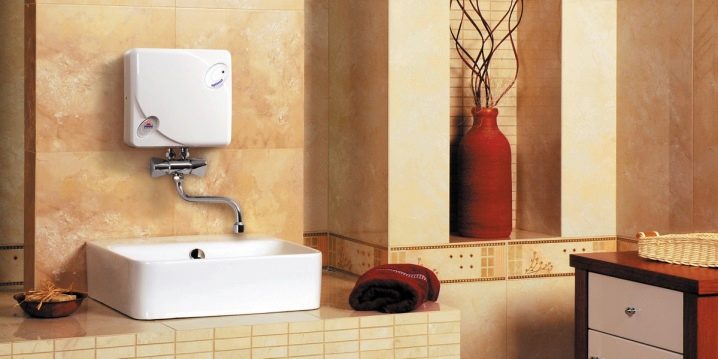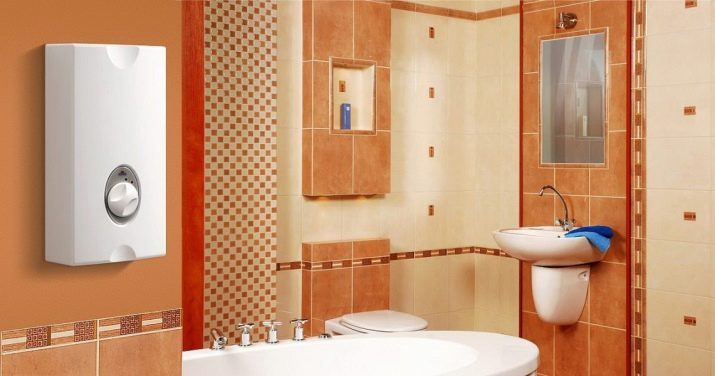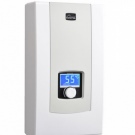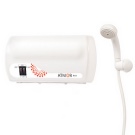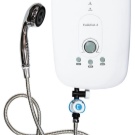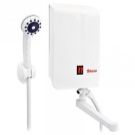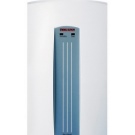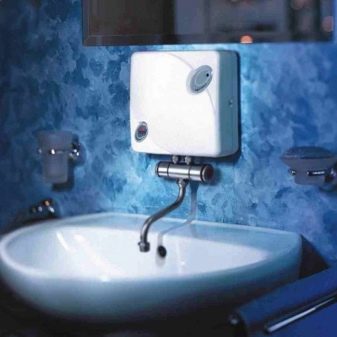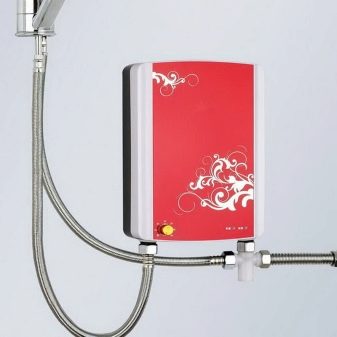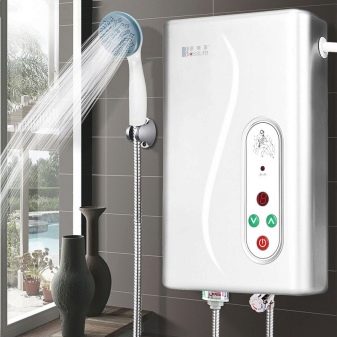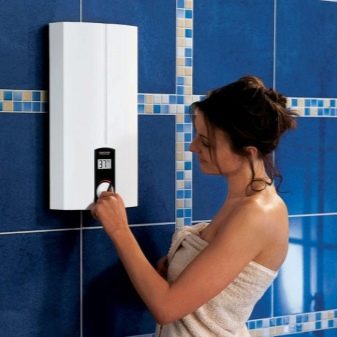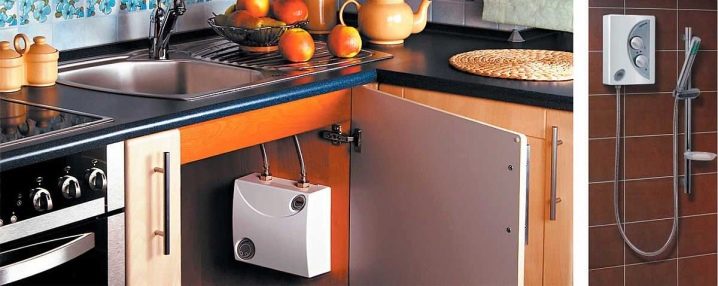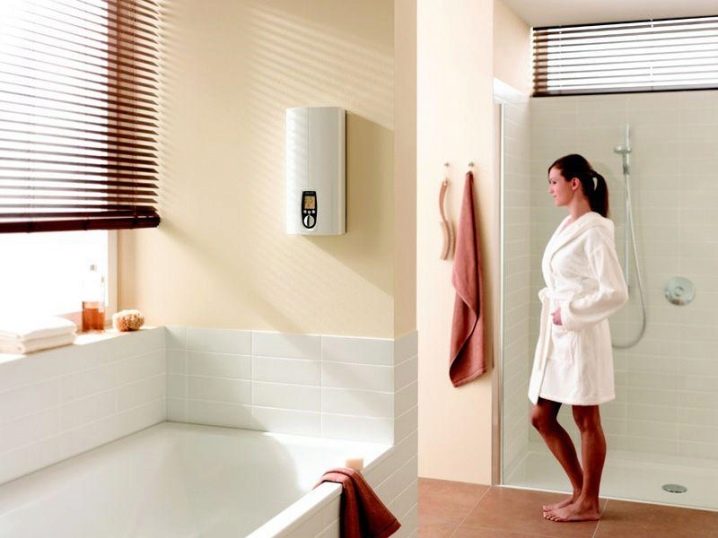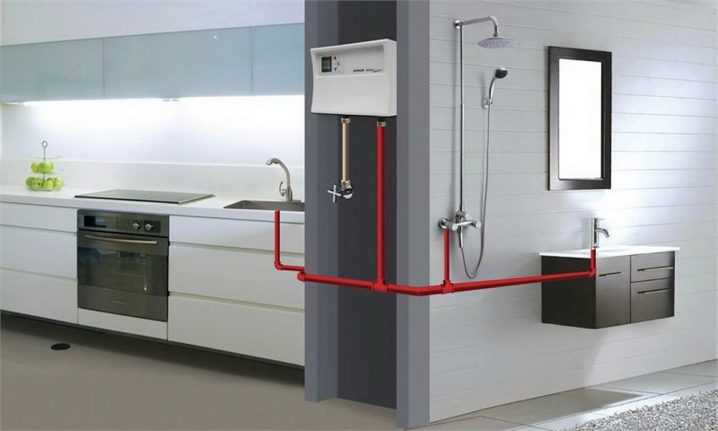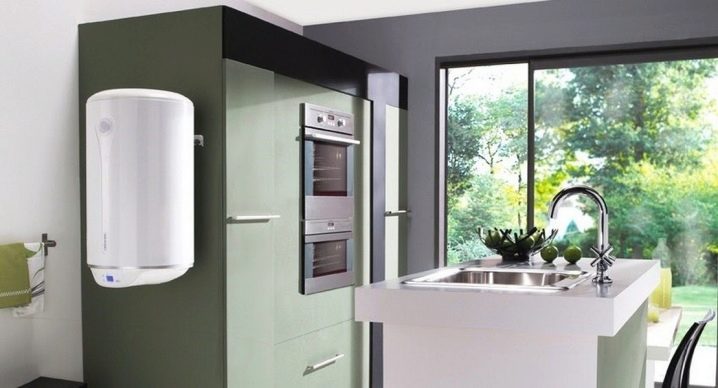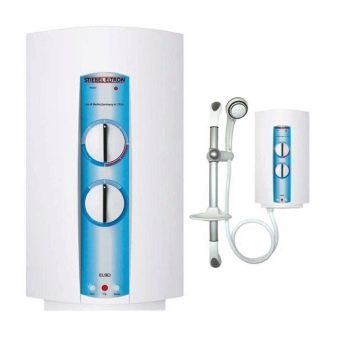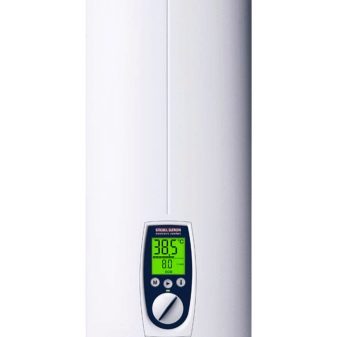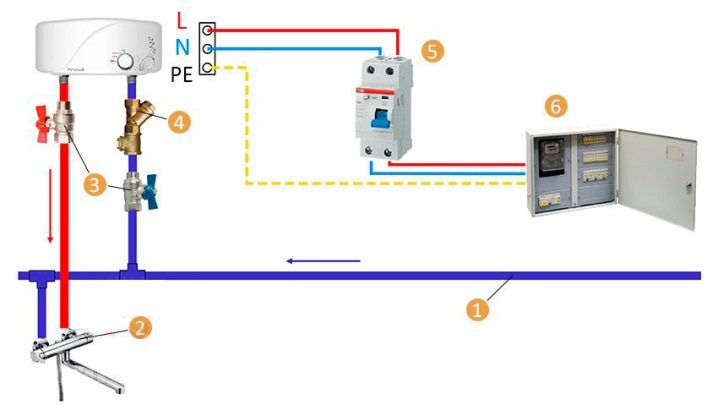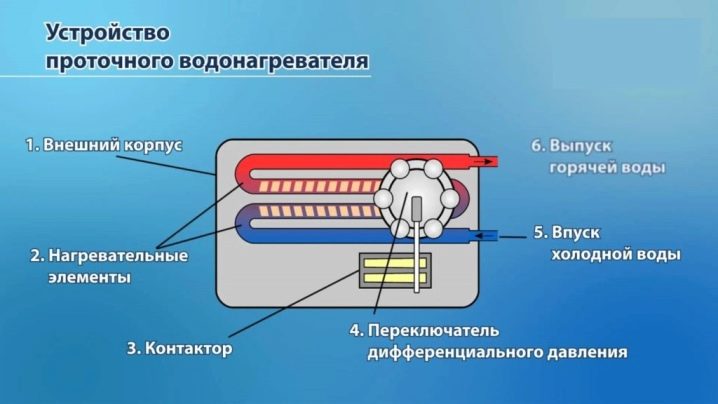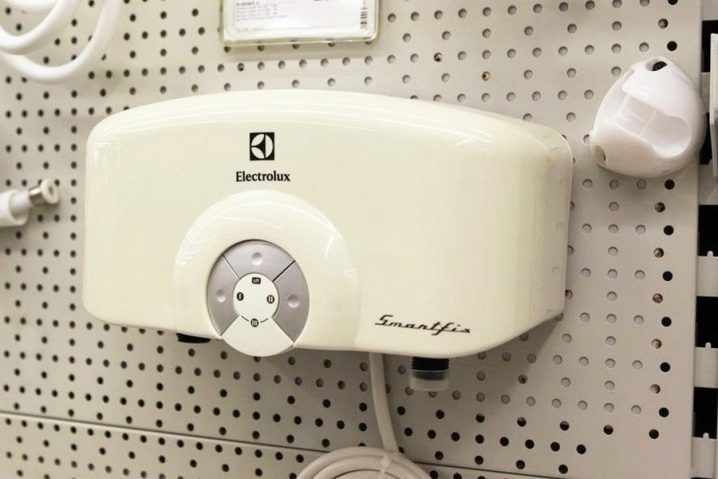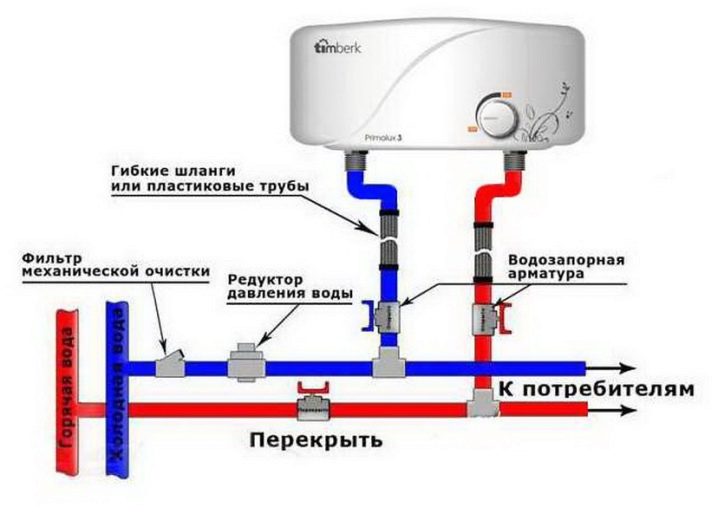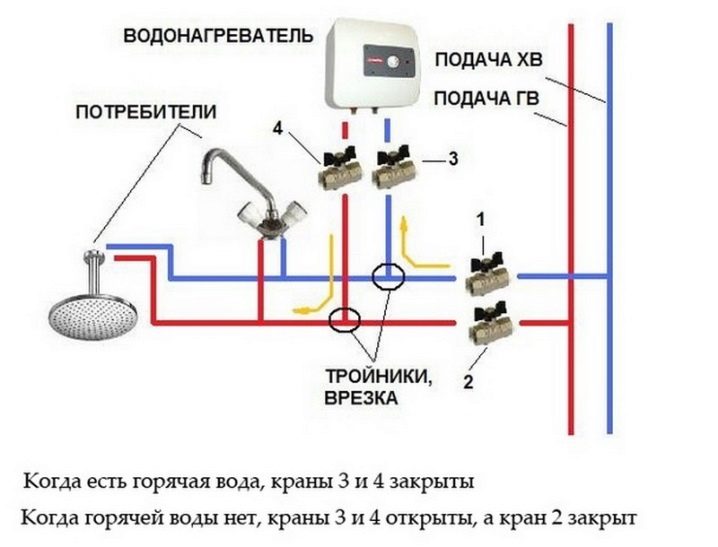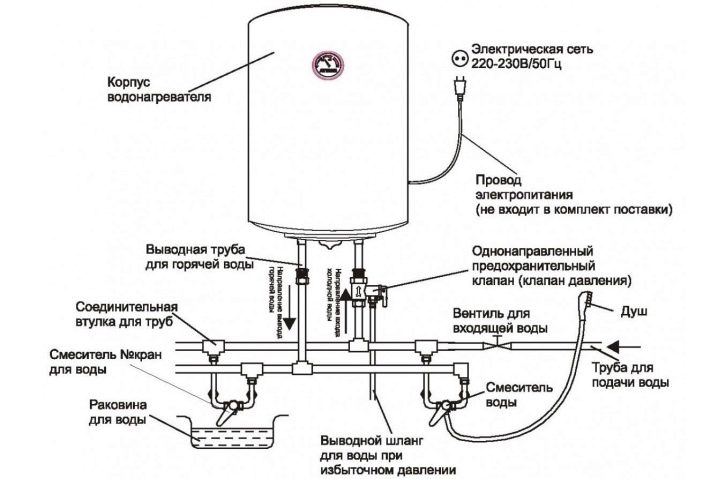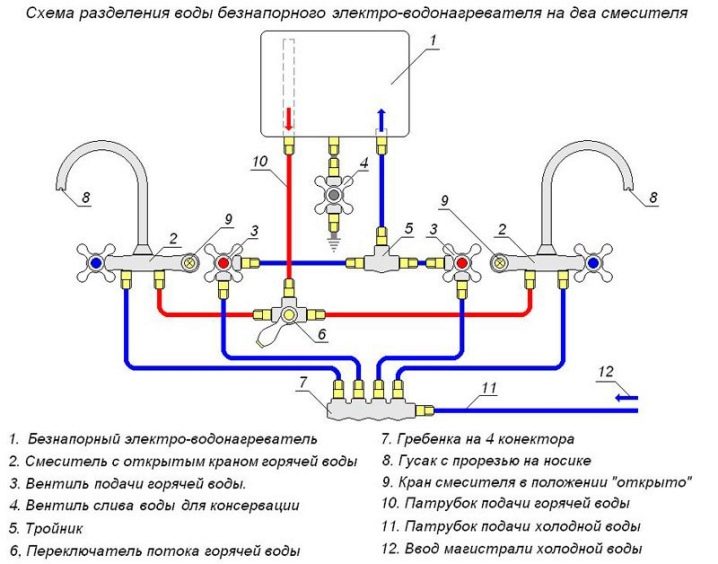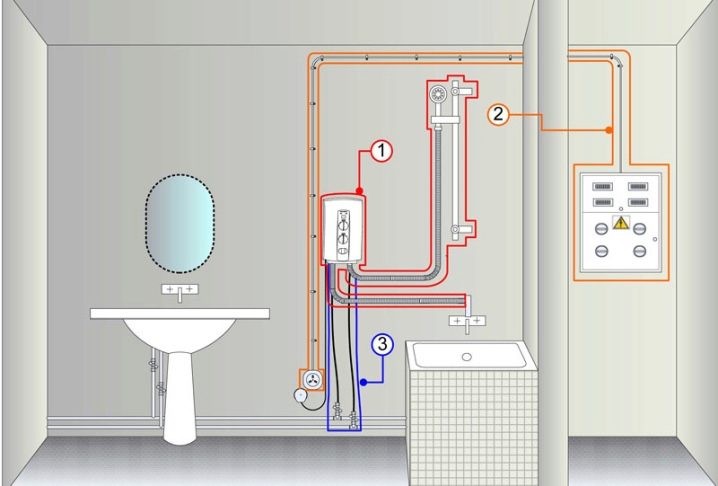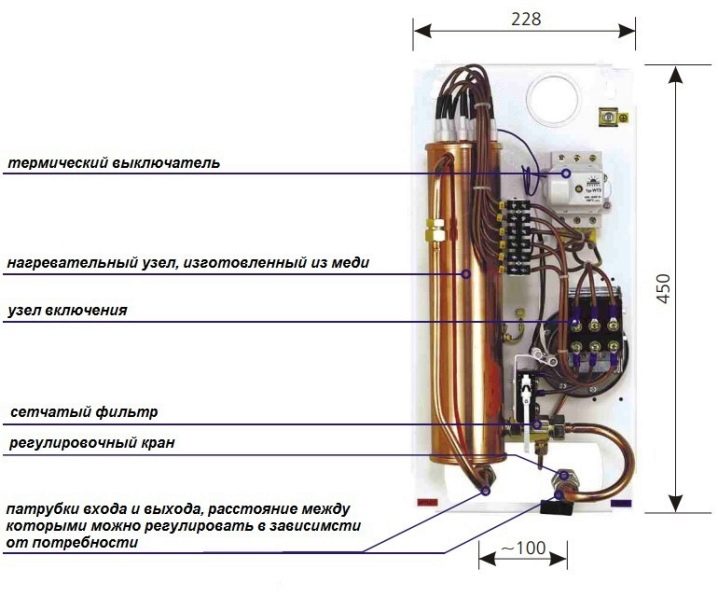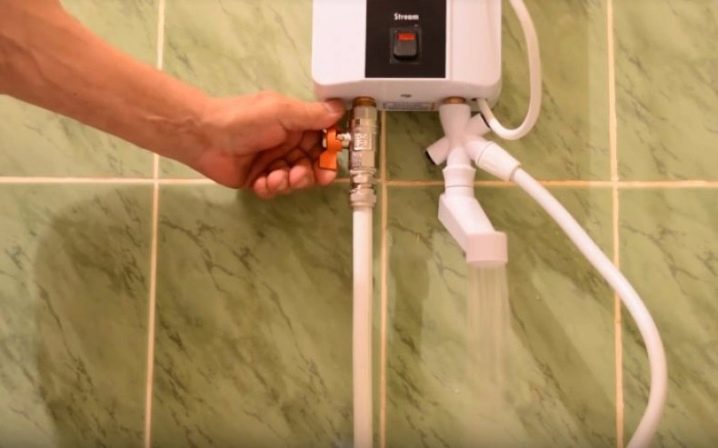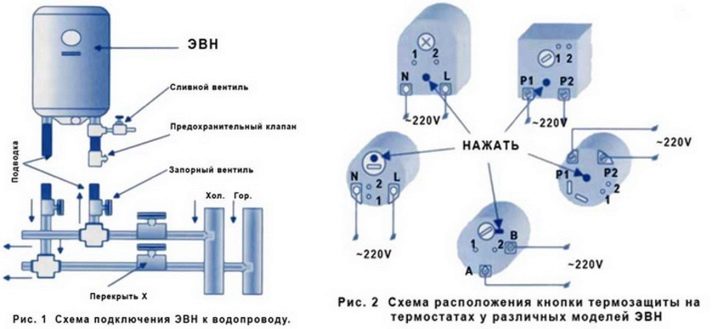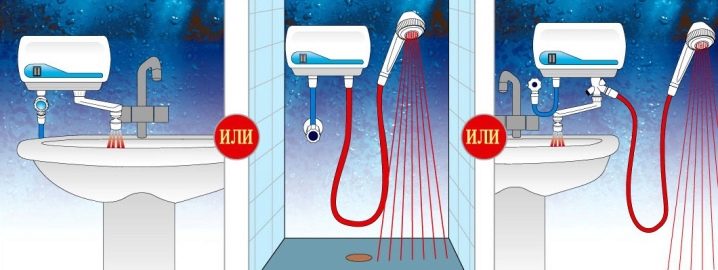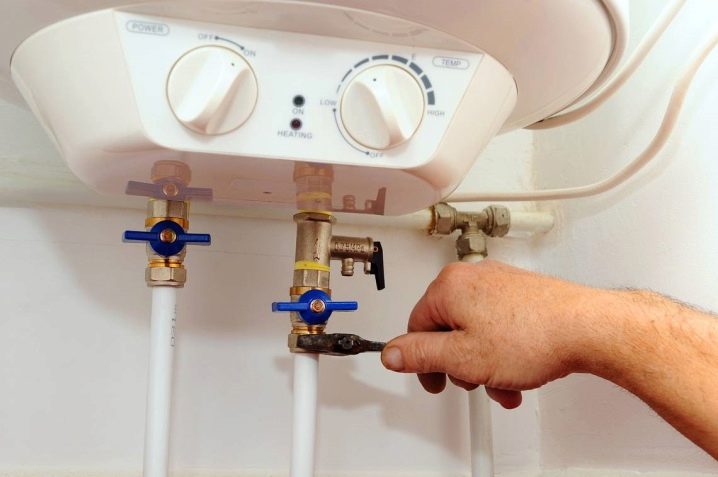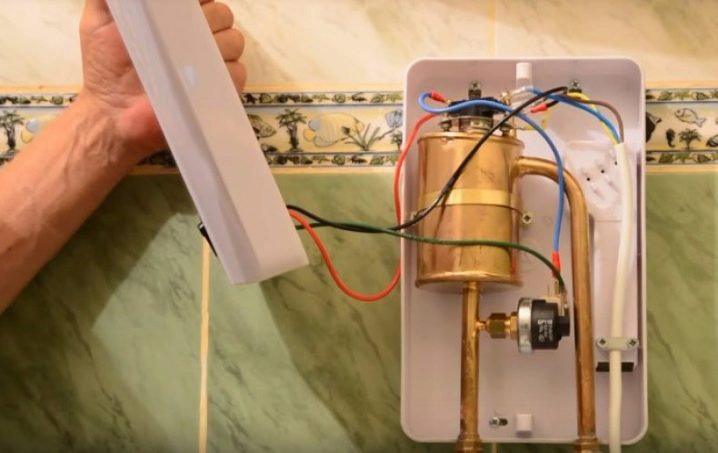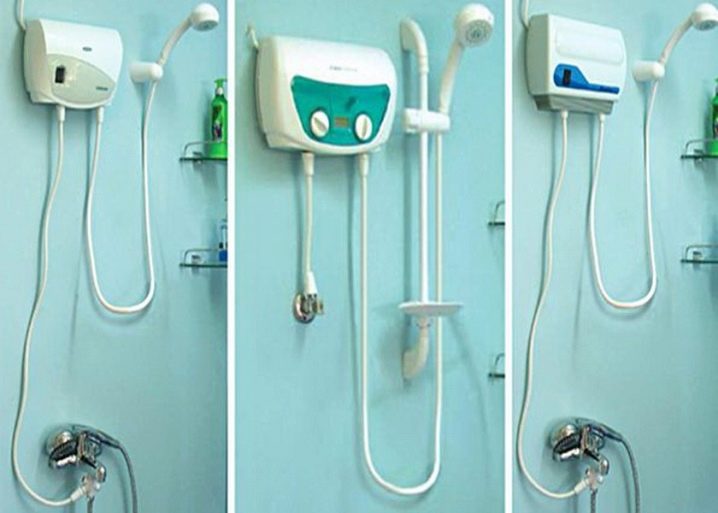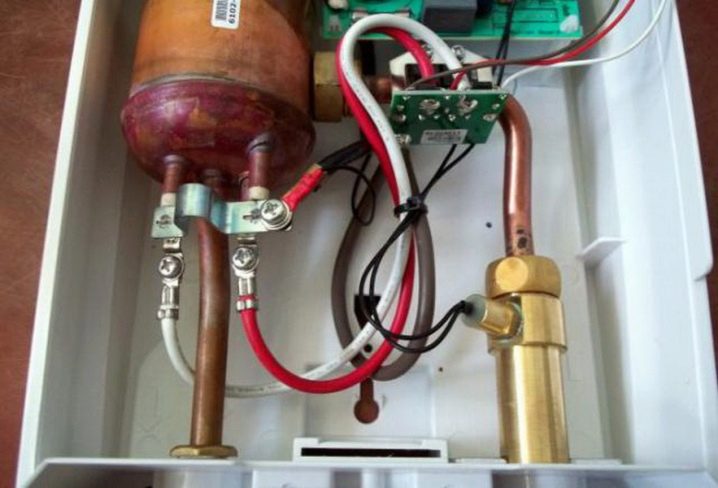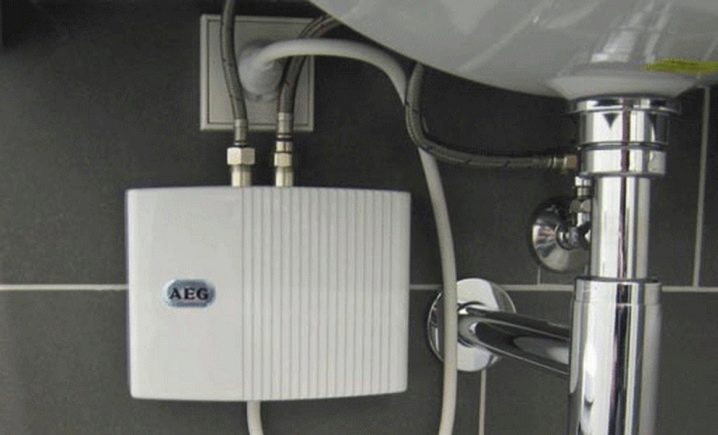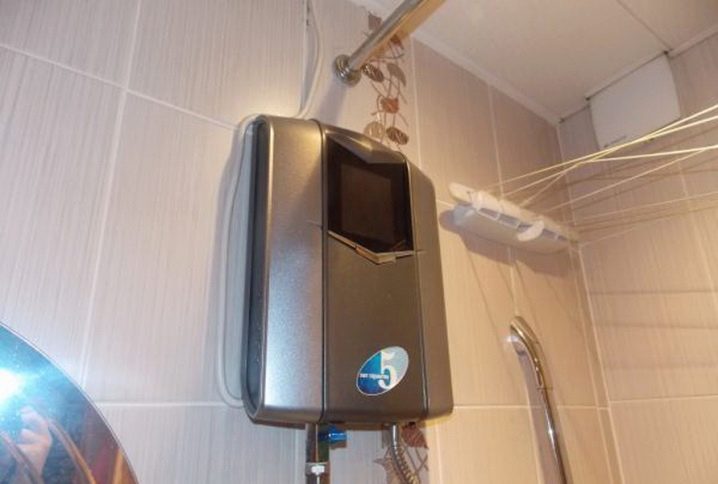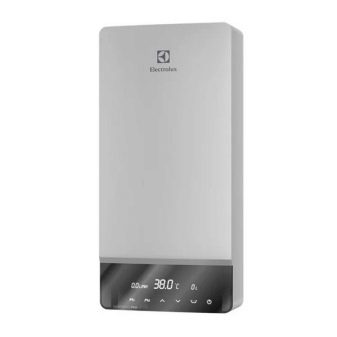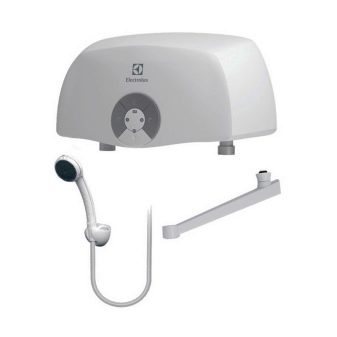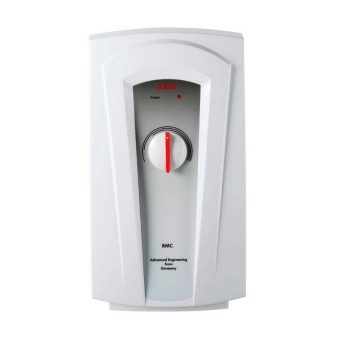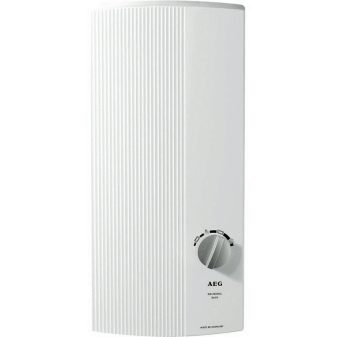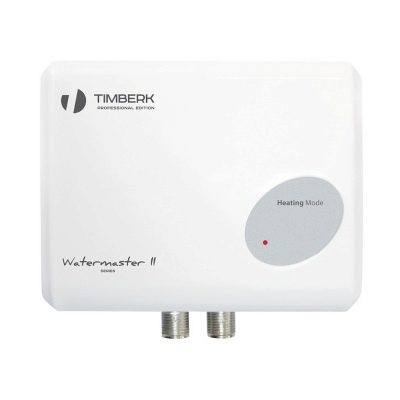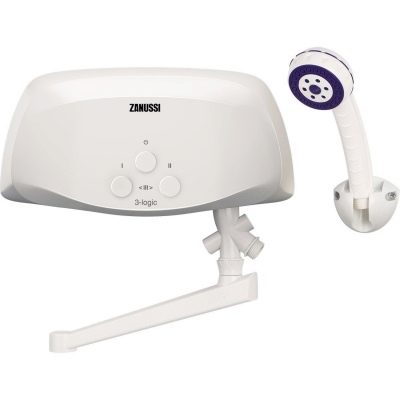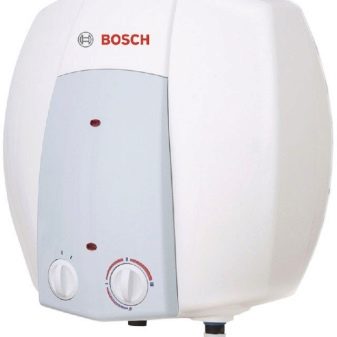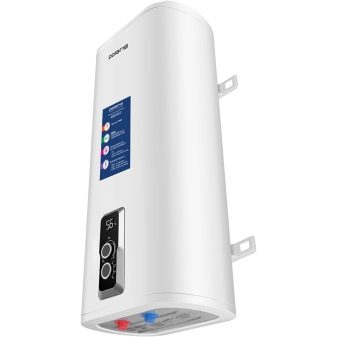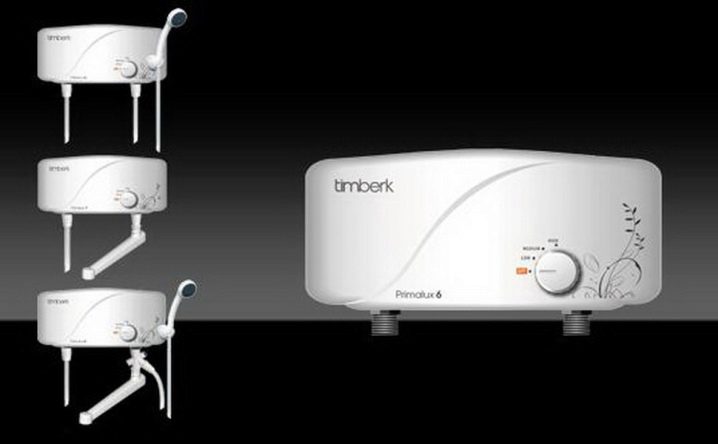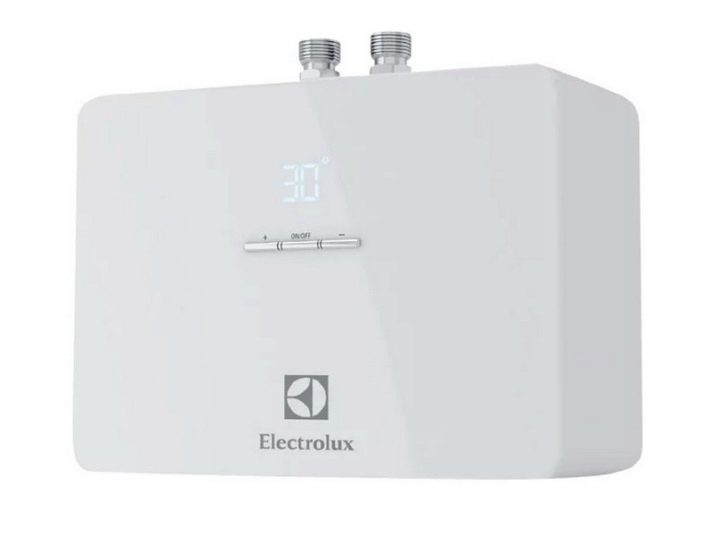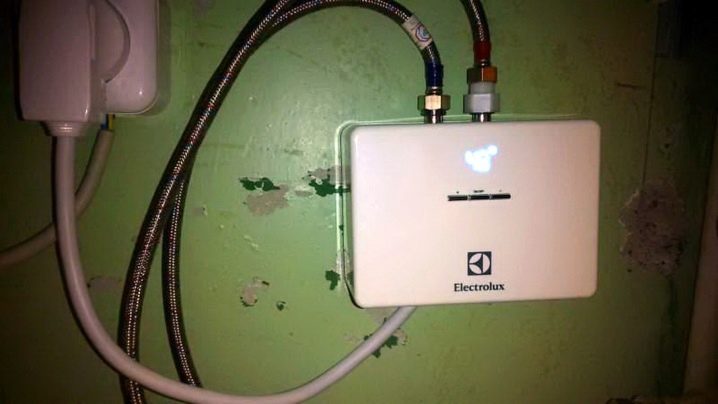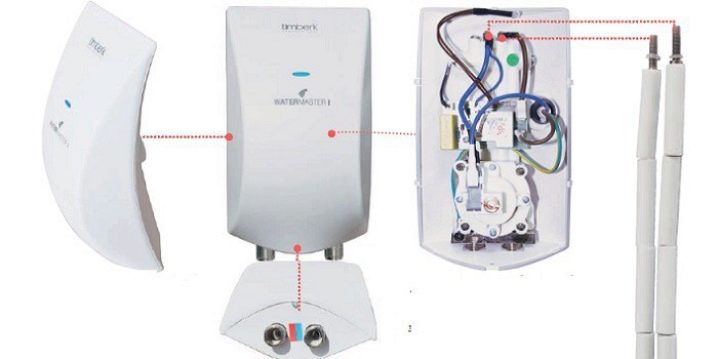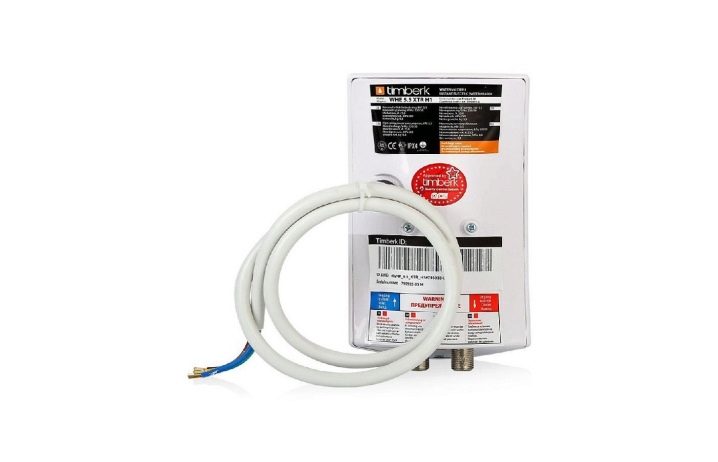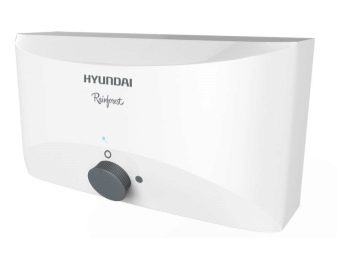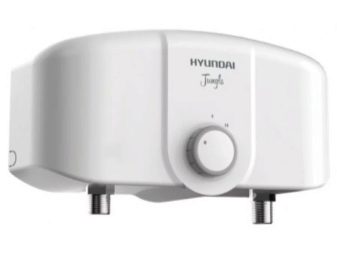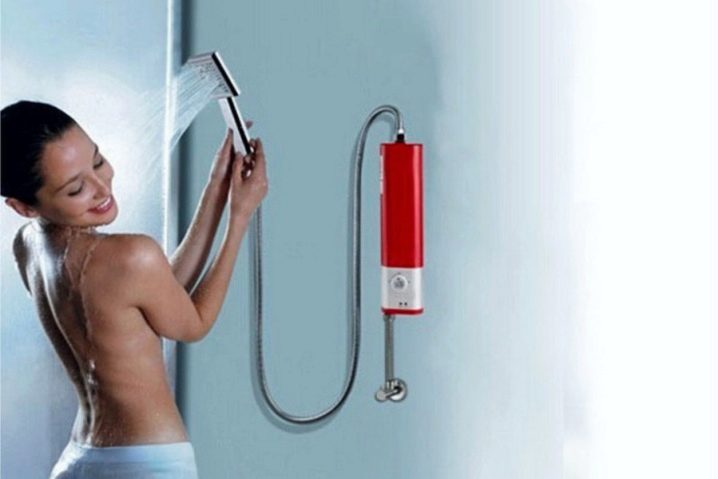Instantaneous electric water heaters: technical characteristics of structures
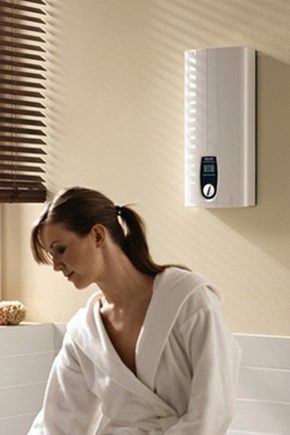
Unfortunately, today not every house or apartment is connected to a hot water network. The reasons for this are different - from the remoteness of the houses from the CHP to the malfunction of the heating mains. And nowadays the presence of hot water in the kitchen to wash the dishes, or in the bathroom to take a warm shower, is no longer a luxury, as in antiquity, but an absolute must. But the situation can be corrected with the help of water heaters - electric or gas.
Electric water heaters are divided into flow and storage.As the name implies, the accumulative boilers pre-collect water to a certain level, and then heat it. Flowing water heaters are distinguished by the fact that they warm up the water passing through them in literally 2-5 seconds.
This article will cover the electric flow heaters.
Special features
The mechanism of action of an electric flow-through water heater is quite simple - the water in it is heated with a high power heater. The device itself is a box with a metal bulb (tank) inside. In the flask and installed induction heater. It has 2 holes - one for the entrance of a cold stream, the second - for the exit of heated water. In mini-models, instead of the heating element, an open heating coil is used, which is not so convenient and safe.
The device is turned on when the cold water tap is opened, and the shut-off is on closing. This process is due to the presence of a flow sensor. It reacts to the appearance / absence of water. The flow is heated to the desired temperature in 3-5 seconds, then the temperature remains at this level until shutdown. In many models, water pressure can be set temperature - reducing the flow force,you raise the temperature of the effluent.
But remember, with too little pressure, many models simply do not turn on. Do not take this for malfunction. Just increase the pressure and check.
pros
Electric instantaneous water heaters have the following advantages.
- The small dimensions of the protochnikov make it easy to find a location for them in the kitchen or in the bathroom, but not in the toilet room, since it will be inconvenient to adjust the modes of operation there.
- There is no need for a separate tank for water heating, therefore, it is not necessary to clutter the apartment with overall tanks.
- The device spends electricity only during operation. Do not forget to disconnect it from the power supply when you turn it off. So you will not only save energy, and therefore your money, but also protect your device from damage.
- Simple installation and use of the device. Of course, you can’t get used to the device right away, but after a few applications you will adapt and turn on the boiler automatically before use, as well as adjust it.
- Do not need a chimney. Since the device uses electricity rather than combustible materials as a power source, there is no need to arrange additional vents.
- Does not depend on ventilation systems.
Minuses
But when using the devices, it turns out that he has disadvantages.
- Large amount of electricity consumed.
- Requires the presence in the house of suitable and serviceable electrical cables. For the device, whose power is higher than 8 kW, it is possible to connect only to a modern three-phase mains with a voltage of 380 Volts. Otherwise, a maximum of 6 kW flow boilers may be installed. You will also have to replace the entire electrical fittings - cheap sockets made in China do not withstand such voltage, they start to heat up and may melt.
- Seasonality of use. This is a property of low power boilers.
- A sharp rise in water temperature can burn your skin. To avoid such problems, select devices with the ability to fine tune the temperature.
- Poor water quality and the poor condition of the water distribution system itself adversely affect the device, its elements quickly become clogged, covered with scale and fail. Even filter pads are not very effective. Most of the parts of the unit can not be replaced, which means that the entire device will have to be thrown away.
- The quality of work depends on the number of water intake points.
- For a house, an apartment, even a single connection of copper and aluminum wires is not safe, and for an electrical appliance it’s twice as dangerous. Aluminum and copper form a galvanic cell with each other, which leads to wire corrosion, short circuit and quite likely to fire.
- Do not think that after buying an expensive and powerful machine of this type, your family will be able to wash the dishes in the kitchen and take a shower or bath at the same time. You will need to set the order of use of the device.
- If you bought a 3 kW electric flow boiler (allowed to be installed in any home), most likely it will be enough only for washing dishes or a weak shower. Do not expect costs to pay for themselves.
- It is recommended that children be bathed only under supervision, because tomboys often like to experiment and risk scalding or causing a short circuit.
In order to minimize the indicated drawbacks, a flowing electric water heater is recommended to be used in conjunction with an accumulative boiler. Such a decision will allow you to prepare for any surprises.It is best to install a hydroaccumulator tank, which will help to survive a complete disconnection from water supply systems.
Kinds
Instantaneous electric heaters are divided into 2 main types: non-pressure and pressure. The second name of pressure boilers - system. They are included in the break in the water supply system and supply two or more points of water extraction with hot water. These are usually high power devices.
Connection of non-pressure (individual) boilers is carried out by means of a rubber hose or a section of a water supply pipe. Have one exit for heated water, differ in low efficiency (from 3 to 7 kW) and the small price. They are produced in various forms:
- separate device;
- crane nozzles;
- The faucet is electrically heated.
If you need a water heater for temporary use (for example, when seasonal hot water is turned off), you can purchase an electric free-flow boiler. If you plan to regularly use the device (for example, in the village, in the country, etc.), it is more practical to choose a pressure model.
Principle of operation
The principle of operation of the flow boiler on the power supply is very simple - cold water,getting into the device, heats up with the help of a heating element or a helix to the required temperature bar and leaves the device through a hot water tap or a shower head. The power of the device depends on the extent to which the device can heat the water. Low-power boilers can only slightly raise the temperature of the incoming water, so they are recommended for installation only for the warm season - from mid-spring to mid-autumn (depending on the region). Or as a short-term measure, during preventive shutdowns of water before and after the heating season.
How to choose?
By purchasing an electric instantaneous water heater, Pay attention to the following indicators:
- number of water intake points;
- the number of people living in the dwelling;
- device type - pressure model or free-flow;
- type of heating control system - electronic or hydraulic;
- instrument power;
- throughput - how many liters of water can miss per minute;
- applied protective technologies;
- water supply method;
- what material the heat exchanger is made of;
- additional items in the package;
- price;
- consumer reviews.
Also consider, for permanent or temporary use you need a boiler.
Wiring diagram
For pressure and non-pressure devices, connection methods are different. System (pressure) flow-through water heaters are connected via a tee into a cold water pipe. This tee is inserted into the plumbing before the first branching. At the water inlets install cut-off taps. These elements are necessary to turn off the device when the central hot water appears. They are also used to dismantle the boiler for replacement or repair.
Due to the poor quality of the water supplied by the water supply, it is highly desirable to put a filter gasket in front of the boiler or in front of the tee. In homes located in the private sector, pressure boilers will function only when the pumping station is working or the system with a hydroaccumulator. Inset it is carried out after the installed filters.
Connection of an individual (free-flow) standardized flow-through electric boiler is made in the same way as an ordinary household appliance. To connect to the cold water supply system, a tap from a pipe with a threaded tap is required.The device is connected to the water supply using a rubber braided hose. The easiest way to connect the electrical flow through the water is through a shower hose in the bathroom.
Remove the installed watering can; instead, screw the hose to enter cold water from the device. If the switch in the bathroom is in the "faucet" position, then the water, without heating, comes out of the faucet. If you turn it into the “shower” position, then the water goes to the appliance and comes out already heated.
There are also spetsnasadki on the tap for heating water. They are not very common due to low efficiency. Usually they are screwed on the end of the gander (spout). Before this, it is necessary to unscrew the grid, which is most often mounted there. Due to the large size of the nozzle can not fasten to a low crane - will interfere. Now, instead of nozzles, more and more electric taps are used with flowing water. They are more effective, they are easy to use and the ability to regulate the temperature. They are mounted instead of the usual faucet on the sink or in the bathroom. But they have one difference - power connection required.
Electrical connection
Any flow-through electric boiler is a fairly high power device, so it requires a separate electric current supply line. In exceptional cases, it is possible to connect to the power line of an electric stove - the parameters of its voltage correspond to those required for a water heater. But do not turn on both devices at the same time - an overload will occur.
The usual connection of the electric water heater to the network is as follows: from the electrical panel, the phase and zero lead to a safety device with two contacts (phase and zero is required), then the phase is connected to the machine, then feeds to the consumer.
Technical data to facilitate the diagnosis of the electrical network and the choice of cable section.
Type of | RMC6E | RMC8E | RMC 10 E |
Nominal volume, l | 0,45 | 0,45 | 0,5 |
Design | closed | closed | closed |
Min inlet pressure MPa (bzr) | 0,02 (0.21) | 0,02 (0.21) | 0,02 (0.21) |
Max. inlet pressure MPa (6ar) | 1,0 (10) | 1,0 (10) | 1,0 (10) |
Water connection | G (male thread) | G (male thread) | G (male thread) |
Dimensions (W x I x) mm | 200x360x110 | 200x360x110 | 200x360x110 |
Weight, kg | 2,0 | 2,0 | 2,0 |
Power settings | 1 / N / PE / AC 220. -240 V | 1 / N / PE / AC 220. -240 V | 1 / N / PE / AC 220. -240 V |
Recommended Circuit Breaker (A) | 32 | 40 | 50 |
Recommended cable cross-section, mm | 4-6 | 6-8 | 8 |
-10 Par. power (kW) / Nom. current iA) | KW -A | KW -A | KW -A |
220 V | 6.0-27,3 | 8,0-36,4 | 9,9 |
230 V | 6,6-28,7 | 8,7-37,8 | |
240 V | 7,1-29,6 | 9,5-39,6 |
The device is connected via a plug (three-pin) with a grounded outlet (this is mandatory). It is possible to install a contact plate or connect the wire directly to the boiler inputs.
Copper wire is used as an electric power line:
- if the power of the electric heater is up to 7 kW, take a wire with a diameter of 3.5 mm;
- if from 7 to 12 kW, then use 4mm cable.
Automatic select the most current consumption (see in the specifications). Take a machine with a nominal slightly higher than the required one (in the case of a smaller value, false alarms are possible whenever the device reaches its peak power). The safety shutdown device should be selected one level higher than the nominal, the leakage rate - 10 mA. When installing an electric flow-through boiler on a wall that quickly heats up, increase the cable cross-section.
Installation
Installation of an electric water heater is a serious and responsible event, therefore it is advisable to entrust this work to specialists. But many consumers have reasons to install this device with their own hands:
- limited budget;
- urgent need for the device;
- the desire to learn new skills (it would be better if this happens under the supervision of a professional);
- the possibility of repair;
- remoteness of housing from large settlements.
The first step in self-installation of an electrical flow-through boiler is to check the electrical network and wiring. Remember that to connect high power boilers you need a new three-phase power grid and high-quality wiring. Otherwise, you risk a fire. If you have a two-phase electrical network with old wiring in your house, you need to completely change all cables in the apartment. Such repair is necessary in the absence of grounding.
The second stage is the determination of the location of the device. The installation location is dependent on the type of boiler. Non-pressure (individual) water heaters in most cases are installed close to the point of consumption (above, below or to the side of the sink). If a hose with a shower head is also included in the free-standing bag, consider its location. Take care also to protect the device from direct moisture.
Do not install the flow in a hard-to-reach place - this is necessary for free mechanical switching on, temperature control and pressure force of the water flow.
Installation of a system instantaneous water heater is most often produced near the maximum loaded point of the water intake or near the riser. A high-power boiler can provide a bath and a kitchen with heated water, therefore the location is selected based on ease of maintenance and expediency. Such devices are programmed in advance, so there is no need for regular configuration.
The third stage - attachment to the wall. To do this, drill holes and suspend the device on special hinges or brackets included in the package. Two requirements that must be met for proper installation:
- a wall of durable material - brick, concrete, wood;
- perfect alignment on planes.
In the course of its operation, the heater must be completely hidden by water, otherwise a part of the heating element will dry out and overheating will occur, due to which the device will break.
Step-by-step instruction:
- turn off the water heater;
- remove the mounting plate (must be included in the kit), attach it to the wall and mark the places for the fixings;
- Drill grooves;
- insert the dowel and tighten the screws;
- fold back the cover and make holes for water flow.
The fourth stage - connection to the network of electric current. Be attentive and careful. Turn off the power grid in your apartment or house. Pull the cable through the hole in the back of the instrument, covered with a rubber plug. Hang the device on the prepared mounts and make sure that there are no horizontal skews. Clean the cable ends and connect the 3 wires to the terminal box.
Tighten the fixing screws to secure each wire. Wires are color coded. Installation is prohibited if there is no safety device and grounding. If a failure or leak occurs, the circuit breaker will disconnect this circuit.
The fifth stage is water connection. Most often, only a few options are used:
- top connection when the appliance is mounted above a water tap;
- the bottom, respectively, below - for example, under the sink;
- connection with open or closed water pipes.
Two openings for the supply of pipes are provided in the housing of the device - they install hoses for cold and hot water. Devices with a small capacity are usually equipped with a hose with a shower for the shower instead of going into a common hot water line.
It is possible to connect the boiler to both the central pipes of the main line and the storage tank, however, it must be located 4 meters above the mounted device. If the supply is from a tank, water level monitoring is necessary. In country houses, cottages, a direct connection to a well or a well is also used, but only with the use of at least a roughly cleansing filter, otherwise you will not receive warranty service.
Manufacturers and reviews
In the ranking there are several manufacturers of manufacturers of electric boilers.
- Electrolux. Centenary Swedish giant manufacturer of household appliances. It also produces flowing electric water heaters, but at very "biting" prices.
- Aeg. The German company, which began its activities in 1887. In 1996, it was absorbed by Daimler AG, but continued production as one of its subsidiaries and retained its brand.
- Thermex. This company specializes in water heaters. Most of its model range is occupied by cumulative boilers, but also flow-through boilers are not deprived of their attention.
- Timberk. One of the youngest manufacturers of quality boilers on the market.This Scandinavian company is about 20 years old.
- Zanussi. The Italian company, founded in 1916 by A. Zanussi. It was originally focused on stoves, washing machines and household appliances. In the second half of the twentieth century, with the change of management of the company, they diversified production. In 1984, it was sold to the concern Electrolux, under whose authority it continues to work.
- Polaris, LG, Bosh - well-known companies produce mainly high-power apparatuses. The disadvantage of their devices are very strict requirements for the electrical network and the laid cables. The installation of such powerful models should be done by professionals, do not risk doing the installation yourself. The safety of the result of the installation should be assured by the housing and utility services, including the fire brigade.
Most often, such devices are mounted in organizations for production or household needs of personnel (especially if the firm is not small).
Consider some of the most successful models from different manufacturers. Timberk WHEL-3 OS. The advantages of this product include:
- the safety lock is provided, there is a protection against an overheat;
- structural reliability;
- power up to 3.5 kW;
- the heat exchanger is made of copper;
- low price;
- The kit includes a hose and a shower head.
Disadvantages:
- refers to non-pressure models;
- low throughput - up to 1.9 liters per minute;
- It is intended for use only in warm seasons.
An excellent choice for summer cottages. Electrolux NPX6 "Aquatronic Digital". Advantages of this model:
- modest dimensions;
- 5.7 kW power;
- there is a digital screen to display and change settings;
- fuse from overheating inside the device;
- the price is not too high.
Minuses:
- poor performance - 2.8 liters per minute.
It is mainly used at summer houses, according to consumer reviews. "Redring Powerstream 8". Advantages:
- high power - 8 kW;
- capacity - 6 liters per minute;
- small product;
- temperature maximum at the exit - 60 degrees;
- thermal fuse;
- copper heat exchanger.
Disadvantages:
- high price;
- relative structural unreliability;
- requires good wiring in the house.
The approximate service life is 3 years (due to a not very successful construction). Timberk WHE 5.5 XTR H1. Pros:
- power - 5.5 kW;
- capacity - up to 3.85 liters per minute;
- very small price;
- overheating fuse;
- small size and weight.
Minuses:
- grounding required;
- unreliability of design.
The best option for those whose budget is limited. But be careful - after a year or two, leaks are possible. Hyundai H-IWR1-3P-CS. Disadvantages:
- very small capacity - the water is warm, but not hot.
Advantages:
- small size and weight;
- water filter;
- The package includes a hose, a faucet and a shower head;
- assembly reliability;
- very small price.
Reliable design provides a long service life, but low power often causes a desire to change the model.
Operation Tips
Problems may arise after a month or two, or after several years of operation of the device. The probability of malfunctions increases with improper use of the instrument Carefully read the instructions for use of the device before purchasing. So you can appreciate all the nuances of its installation and use. When you turn off the device, first turn off the device, and only then turn off the cold water. When turned on, on the contrary, first open the tap with water, and then turn on the water heater. If you follow this procedure, the risk of burnout will be minimal.
Free-flow flow boilers in the shower head included in the device package have very small holes.This is done to save energy consumed by the device and to increase the water pressure with a minimum flow. Over time, these holes "overgrown" scum and clogged with water impurities. To prevent this situation from occurring, it is recommended to place a nozzle in front of the boiler during installation of the device to clean water from impurities and litter. Every few months the filter requires cleaning from dirt and scale.
Small "protochniki" installed for the summer season at the summer cottage, in the autumn it is better to dismantle and store in a warm room. Reconnecting next year will not require a lot of effort, and it will not be easy to ensure proper storage conditions in an unheated house. Of course, you can install the electric flow boiler yourself. But at the same time you risk losing warranty service and shorten the service life of the device. This is especially true for high-power system water heaters.
How to choose a flowing electric water heater, see the following video.
